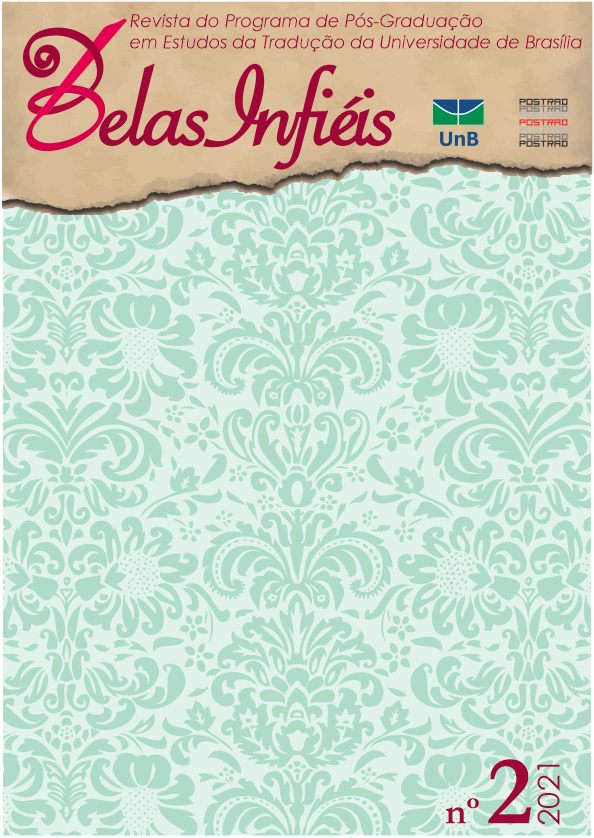Analysis of Portuguese - Chinese Translation Textbooks Published in China Based on Nord's Considerations on Translation Competencies
DOI:
https://doi.org/10.26512/belasinfieis.v10.n2.2021.32964Keywords:
Training. Translators. Translation classes. Portuguese course. Chinese universities.Abstract
In applying her Model for Translation-oriented Text Analysis in the training of professional translators, Nord (2006, p. 155) postulates that the focus should be on developing transfer competence [“translation competence” in the narrower sense (Nord, 2006, p. 161)]. However, according to Nord (2006, p. 161), in translation classes, besides the consolidation of transfer competence, four other competencies (linguistic, cultural, factual, and technical) can also be enhanced. As an essential part of translation classes, translation textbooks play an indispensable role; by analyzing them, we can learn how these competencies are developed in classes. In the present work, we will examine three Chinese translation textbooks from Portuguese to Chinese and vice versa, based on Nord's considerations regarding the five translation competencies (transfer competence, linguistic competence, cultural competence, factual competence and technical competence). Through these analyses, we aim to understand how the consolidation of these five competencies is reflected in the structures and contents of the textbooks in question.
Downloads
References
AS-SAFI, Abdul Baki. (2011). Translation Theories: Strategies and Basic Theoretical Issues. Amman: Dar Amwaj.
CATFORD, John Cunnison. (1965). A Linguistic Theory of Translation. London: Oxford University Press.
LI, Changsen. (2002). Aspectos Teórico-Práticos de Tradução ”“ Portuguê/Chinês. Macau: Instituto Politécnico de Macau.
LI, Fei. (2012). Sebenta de Tradução Português - Chinês, Chinês ”“ Português. Macau: Instituto Politécnico de Macau.
MUNDAY, Jeremy. (2016). Introducing Translation Studies: Theories and Applications (Fourth Edition). London and New York: Routledge.
NIDA, Eugene. (1991). Theories of Translation. TTR: traduction, terminologie, rédaction, 4(1), 19”“32.
NORD, Christiane. (2006). Text Analysis in Translation: Theory, Methodology, and Didactic Application of a Model for Translation-Oriented Text Analysis (2nd Edition). Beijing: Foreign Language Teaching and Research Press.
SHUTTLEWORTH, Mark; COWIE, Moira. (1997). Dictionary of Translation Studies. London and New York: Routledge.
WANG, Jinquan. (2004). Translation Memory (TM) - A New Development of Computer Translation Technology. New Technology of Library and Information Service, (5), 13-16.
WANG, Rong. (2001). Trados and Microsoft Further Strengthen Localization Cooperation - Multi-language Translation Technology Will Help Microsoft Enhance Localization Capabilities. Chinese Science & Technology Translators Journal, 14(4), 61.
YU, Xiang. (2011). Tradução Português-Chinês: Teoria e Prática. Beijing: Foreign Language Teaching and Research Press.
YUAN, Yining. (2005). Translation Technology and the Formation of Technical Translation Talents in China. Chinese Science & Technology Translators Journal,18(1), 51-54.
Downloads
Published
How to Cite
Issue
Section
License
Copyright (c) 2021 CC BY

This work is licensed under a Creative Commons Attribution 4.0 International License.
Given the public access to this journal, the texts are free to use but requires the recognition of the original authorship and initial publication in this journal to be properly stated.
 The journal allows the use of works published for non-commercial purposes, including the right to submit the work to publicly accessible databases. Published contributions are the sole and exclusive responsibility of the author(s).Â



















